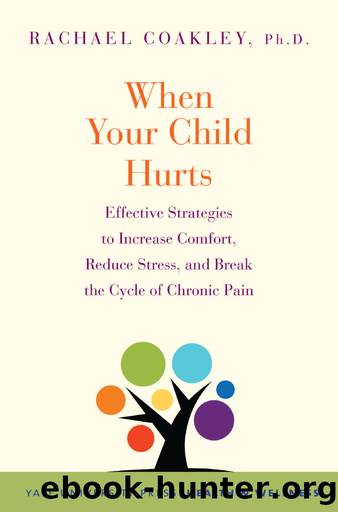When Your Child Hurts by Rachael Coakley

Author:Rachael Coakley [Coakley, Rachael]
Language: eng
Format: epub
Publisher: Yale University Press
Published: 2015-12-14T16:00:00+00:00
14
Biofeedback
Pain and stress both trigger the sympathetic nervous system, which in response will automatically prepare the body for âfight or flight.â A person feeling pain or stress will thus commonly experience physiological changes such as an increased heart rate, shallow breathing, elevated blood pressure, slowed digestion, decreased blood flow to the extremities, and increased muscle tensionâall in preparation for running away or mounting a defense. Relaxation exercises like diaphragmatic breathing, guided imagery, progressive muscle relaxation, and mindfulness are explicitly designed to activate the parasympathetic nervous system response, otherwise known as the relaxation response. The parasympathetic system overrides the sympathetic activity, and so will reduce blood pressure, slow the heart rate, restore digestive function, increase blood flow to the extremities, and relax the musclesâin other words, it will restore the body to a healthier state. But how do you or your child really know if the parasympathetic systems are fully engaged and helping? In other words, how do you know if the relaxation exercises are working?
One way to know for sure if your child is triggering the relaxation response is to talk to your child about how he or she feels. If your child feels relaxed, soothed, less stressed, more focused, or more comfortable after engaging in any relaxation exercise, then you know that itâs working. You can also observe your childâs response. If your child is focused and engaged and actively participates with you in these activities, then you should be assured that he or she will benefit from them. But if either you or your child is uncertain, or if you have a difficult time engaging your child in relaxation work, then it may be worthwhile to consider a biofeedback approach.
What Is Biofeedback?
The word biofeedback simply denotes getting information (âfeedbackâ) from the body (âbioâ). The term first became popular in the late 1960s. At that time biofeedback was used to describe laboratory procedures that trained research subjects to alter their own brain activity, blood pressure, muscle tension, heart rate, and other bodily functions that are not normally controlled voluntarily. Over the last fifty years, due in part to a robust research literature supporting the efficacy of this technique, biofeedback has moved out of the laboratory and into mainstream culture. Currently the term is used to describe a mind-body training technique in which people are taught to improve their health and physical performance by using signals from their own bodies. Biofeedback, or biofeedback-assisted relaxation therapy (BART), essentially helps people learn how to gain control over the automatic nervous system by showing them the physiological differences between the activated sympathetic nervous system and the relaxed parasympathetic response.
Biofeedback involves equipment that takes real-time assessments of internal body functions such as heart rate, breath rate, muscle contraction, or temperature and makes them outwardly observable. A simple medical device such as a thermometer is essentially a biofeedback tool, because it provides information that allows a person to make a health-related decision. For example if a thermometer reveals that a personâs body temperature is high, she may decide to hydrate, rest, or take medication until symptoms resolve.
Download
This site does not store any files on its server. We only index and link to content provided by other sites. Please contact the content providers to delete copyright contents if any and email us, we'll remove relevant links or contents immediately.
| Administration & Medicine Economics | Allied Health Professions |
| Basic Sciences | Dentistry |
| History | Medical Informatics |
| Medicine | Nursing |
| Pharmacology | Psychology |
| Research | Veterinary Medicine |
Bioenergetica by Alexander Lowen(1123)
Noise: A Flaw in Human Judgment by Sunstein Cass R. & Sibony Olivier & Kahneman Daniel(968)
The Data Detective by Tim Harford(944)
The Child in You by Stefanie Stahl(883)
Chatter by Ethan Kross(799)
The Science of Rapid Skill Acquisition by Peter Hollins(639)
Freedom by Sebastian Junger(633)
No Bad Parts by Richard C. Schwartz(604)
The Montessori Baby by Simone Davies(565)
Evolution Gone Wrong: The Curious Reasons Why Our Bodies Work by Alex Bezzerides(560)
The Quantum Psychiatrist: From Zero to Zen Using Evidence-Based Solutions Beyond Medication and Therapy by Biswas Dona(551)
Maps of Meaning: The Architecture of Belief by Jordan B. Peterson(550)
The Science of Self-Learning: How to Teach Yourself Anything, Learn More in Less Time, and Direct Your Own Education (Learning how to Learn Book 1) by Peter Hollins(522)
Anxiety For Dummies by Charles H. Elliott & Laura L. Smith(512)
Sadomasochism and the BDSM Community in the United States by Stephen K. Stein(498)
Disconnected by thomas Kersting(481)
Why Sex Doesn't Matter by Olivia Fane(480)
The Mechanics of Passions: Brain, Behaviour, and Society by Alain Ehrenberg(480)
Jung - The Key Ideas: Teach Yourself (TY Philosophy) by Ruth Snowden(468)
